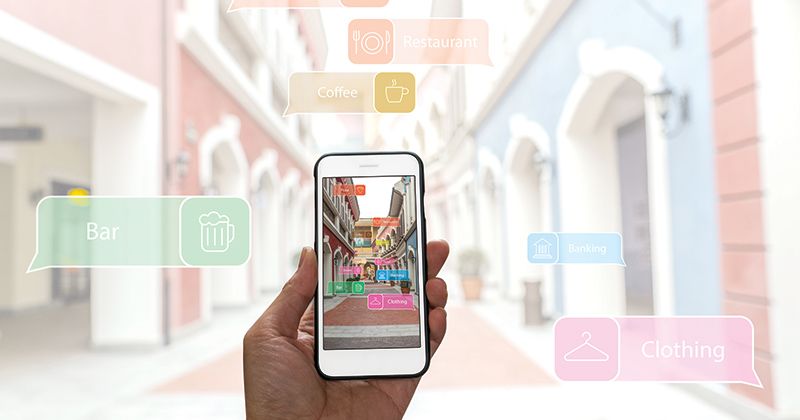Are Augmented Reality Sales Tools Ready for Prime Time?
Here’s how to look at AR with clear eyes.

Augmented reality (AR)— technology that superimposes a computer-generated image over a user’s view of the real world—could potentially transform the roles of salespeople. In fact, the B2B research firm Markets and Markets estimates the AR market will grow from $2.4 billion in 2016 to $61.4 billion by 2023.
As a sales tool, AR applications allow consumers to visualize how items from furniture to cosmetics could potentially fit in a physical space. But despite AR’s ability to better engage consumers, the technology is only as powerful as its connected experience.
Who’s doing it?
AR technology allows digital objects to be scaled and placed correctly within a physical space by detecting where the object is in the spatial layout of the camera view. Augmented reality has the power to significantly personalize the marketing and sales experience by helping customers understand exactly how a product fits into their world.
For example, Wayfair, the online furniture retailer, created a “View in Room” feature within its app that uses Google’s AR technology, Tango, to let shoppers see how 3D images of furniture would look in their home through their smartphone. Shoppers can then buy the product within the app or save it on an idea board.
Lowe’s also used Tango to power its Lowe’s Vision: In-Store Navigation app. In select stores, customers can use the app to add products to a shopping list and then locate the product by following directional prompts overlaid onto the real world. The program is designed to guide customers around the store using the most efficient route.
AR also provides a personalized experience through new touchpoints. Beauty brands like Sephora, for instance, are experimenting with software that offers shoppers personalized experiences without the need of a store or an associate. The Sephora app uses augmented reality technologies to overlay makeup product shades and styles on users’ faces. At the bottom of the trial screen is a buy button, which guides shoppers through the checkout process.
The B2B space is also adopting AR as a sales tool. Instead of sales executives carrying products to meetings with prospects, AR provides a way to easily examine and test prototypes in a virtual space. Also, some products are complicated, and it can be difficult to abstractly explain how these products work and what their value proposition is.
Traditional methods such as white papers and videos can help, but AR can simplify a complex sales pitch even further by allowing customers to examine the products before installing or purchasing them. For example, using a tablet, a prospective client could examine 3D images of a machine’s exterior and interior components that the company is considering purchasing. Organizations may also use augmented reality in a maintenance scenario to help technicians find out exactly how to solve a problem by superimposing relevant instructions on the machine based on the type of problem and the knowledge level of the technician.
It’s all about the data
Indeed, augmented reality can make a salesperson’s job significantly easier by enhancing a prospective customer’s first experience with the product. A potential pitfall, though, is to become too reliant on AR or any tool to close a sale by itself. After introducing customers to their products via augmented reality, it’s critical that companies follow up with a strong customer acquisition and conversion strategy.
Here are a few questions sales and marketing leaders should ask themselves:
• What is the follow-up strategy to customers using
the AR app?
• Is the app connected to a CRM system?
• What insights can we hope to learn from the app?
• Is it easy to track user activities on the app?
And, if the app is collecting data about users, what is the company doing with the data? Can it use the data insights to personalize follow-up messages for the customer? Can the app be further improved based on those insights? As Forrester analysts Dipanjan Chatterjee and Sheryl Pattek note in a report, Brand Management for a New Age: Experience and Resonance Transform Brand Leadership, “digital business professionals should consider or test AR as a tactic because AR is not a strategy or end in itself.”
Consider Pokémon Go, the augmented reality mobile game that rapidly attracted an incredible number of players in 2016. Within a week after it launched, comScore reported that the game had 28.5 million daily unique users in the U.S. (about 15 percent of smartphone owners). Perhaps more important than the game’s popularity was the massive amount of data insights that it generated.
“Pokémon Go has opened our eyes in many ways,” writes Peter Warman, CEO of the market intelligence firm Newzoo, in a blog post. “It has proven beyond a doubt that AR can be applied in ways that appeal to a mass audience. Equally important from a business perspective, it has given Niantic investor Google enormous insight and data that it can incorporate into its location-based advertising and services strategy.”
Pokémon Go has generated huge amounts of data about its users’ location, movement patterns, and user behavior, like how often they open the app and the amount of time spent on it. The data helped Nintendo and Niantic make updates and improvements to the game and most likely provided plenty of insights.
Even without access to the user data, businesses found ways to capitalize on the game’s success. Restaurants and shops that were lucky enough to be “PokéStops” took full advantage by advertising their status to app users and potential customers. Others that weren’t PokéStops could buy “lures” to attract Pokémon to their location and thereby attract users.
It’s unquestionable that augmented reality will have a significant impact as a sales tool. It gives salespeople new opportunities to interact with customers and companies are sure to find even more ways to leverage it. But like any tool, the value of AR lies in how it’s connected to a company’s customer strategy. And no matter how impressive augmented reality may be, the reality is much still depends on the salesperson’s relationship with the customer and the company’s offering. The sooner companies realize this, the sooner they can get ahead.





